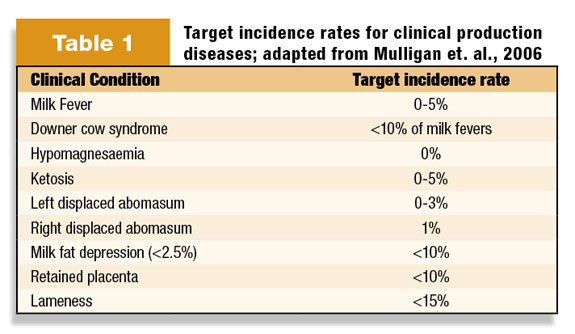The transition period of a dairy cow is one of the most crucial and vulnerable stages of a lactation cycle. During the last three weeks before calving through to the first three weeks of lactation, your cows’ metabolic needs dramatically increase. How the animal copes with this high-energy transition can have a drastic impact on how well she will perform throughout the remainder of her lactation. Research has shown that at the time of calving, a cow’s requirement for calcium increases fourfold, glucose demand triples and protein requirements double.
Meeting these nutritional demands is crucial to prevent transition diseases such as ketosis, milk fever or displaced abomasum (DA) and decrease the risk of developing other diseases such as mastitis and retained placenta.
These transition diseases will not only affect the overall health and well-being of the cow, but will also decrease her milk production and lactation potential.
It has been shown that transition diseases can result in a loss of 5 to 10 pounds of milk each day at peak lactation. A decrease of 1 pound of milk per day during peak lactation can result in a 200-pound loss of milk for the entire lactation, which results in a decreased profit for the producer.
Researchers have noted that when a cow suffers from one transition disease, she is more likely to develop another; a cow with ketosis is eight times more likely to develop a DA, or a cow with milk fever is eight times more likely to develop mastitis early in lactation.
Research has also shown that the highest proportion of culls are made early in lactation because of complications during this transition. With potential losses like these, it is easy to see that an effective transition cow program is essential to the success of a dairy operation.
It can be difficult to assess whether or not your transition program is effective at preventing disease. Accurate record-keeping is essential for daily management on your farm, particularly when it comes to monitoring the health and performance of your herd.
When discussing your transition cow program with your veterinarian and nutritionist, it is important your records are detailed and up-to-date, allowing for accurate analysis leading to an effective plan of action.

Prevention
As many producers know, prevention tactics are the key to success when it comes to combating the effects of disease. Researchers have identified target incidence rates for many common clinical transition cow problems, as shown in Table 1 .
These guidelines may differ in your herd depending on the criteria for identifying each disease; however, they are excellent benchmarks to strive for when developing a transition program.
Meeting these targets comes down to a few key items: maximizing dry matter intake, maintaining proper body condition score, maintaining rumen health, maintaining trace mineral levels and preventing milk fever.
Maximizing dry matter intake of your fresh cows is essential to preventing transition problems in your herd. Fresh cows suffer from what researchers refer to as a “negative energy balance,” where the demand for milk production outweighs what the cow is able to consume.
Research has demonstrated the optimal stocking density in freestall pens for fresh cows is 90 percent – above this, dry matter intake becomes depressed.
Other recommendations that have shown to increase feed intake include feeding 2 to 3 percent above the animal’s required intake, offering the refusals to late-lactation cows or heifers, housing fresh cows close to the parlor to minimize time spent in transit or standing in the holding area, preventing slippery floors and providing adequate water availability.
By improving dry matter intake, you are also limiting the incidence of subacute ruminal acidosis, which is critical for maintaining an effective transition cow program. If more than 10 percent of fresh cows have a depressed milk fat test below 2.5 percent, or more than 15 percent of cows at peak lactation are lame due to laminitis, SARA may be an issue to address in your transition herd.
Monitoring and maintaining a good body condition is one of the most crucial factors in maximizing dry matter intake. During the period of negative energy balance, cows must mobilize fat stores to meet the demands of milk production.
Problems arise when energy intake is limiting, to a point where excessive fat stores are metabolized. This causes a buildup of ketones in the blood, resulting in the condition we refer to as ketosis.
Overconditioned or fat cows are more likely to suffer from ketosis, as researchers have demonstrated that cows with a body condition score of greater than 4 will experience a reduced dry matter intake. Testing for ketosis is easily done using ketone strips, available for both milk and urine samples.
If clinical ketosis levels in your herd are higher than 5 percent, the condition of your transition cows should be examined. When condition scoring your cows, it is best to compare your scores with those of your veterinarian and nutritionist, to improve your accuracy for assessing the condition of each cow or group.
Milk fever, or hypocalcemia, is the most important macro-mineral disorder that can affect the transition dairy cow. Milk fever can be characterized as a depression in blood calcium levels, often resulting in a downer cow.
This has been associated with increased incidences of mastitis, calving difficulty, uterine prolapsed, retained placenta, ketosis and DA, as well as decreased feed intake. Cows become more susceptible to milk fever with age, as older animals have lesser ability to mobilize their calcium stores.
Blood sampling cows 12 to 24 hours post-calving to examine blood calcium levels is an effective tool to monitor milk fever levels; however, consult your veterinarian before doing so.
Keeping milk fever levels below 5 percent in your herd can be attained through adjusting the macro-mineral balance of the close-up cow diet – by choosing low-potassium forages or anionic salts as opposed to feeding diets low in calcium. Before incorporating anionic salts into your dry cow diet, consult your nutritionist.
Treatment
Developing effective treatment protocols for your transition cows can allow you to address any health problems quickly and efficiently in your herd to alleviate adverse symptoms cows are experiencing. However, the success of these protocols is highly dependent on the accuracy of recording disease events.
The success of a transition cow treatment program requires rapid and accurate identification of sick animals, and treating them with corresponding therapies in a timely manner.
Most herdsmen do a fantastic job of treating sick animals; however, identifying these animals quickly is where their largest opportunity lies. Discuss with your veterinarian what methods of disease detection could work best for your operation, as well as corresponding treatment protocols.
For larger herds, it is also essential to monitor animals under the care of individual employees, to ensure all protocols and treatments are being adhered to correctly.
The success of any transition program relies heavily on accurate, timely record-keeping and identification of sick cows. Setting clear guidelines to classify and detect each transition disease is essential when developing a successful prevention protocol.
It is imperative you work together with both your veterinarian and nutritionist to develop or revise your transition cow program for improved health, production and well-being in your herd. PD
References omitted due to space but are available upon request to editor@progressivedairy.com .

Matt Walpole
Ph.D. Student
Ruminant Nutrition and Physiology
University of Saskatchewan
matthew.walpole@usask.ca








